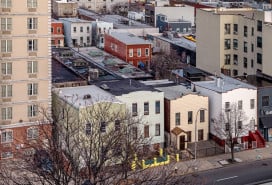Ask Altagracia: I live in a 421a rental building. How long will my apartment be rent stabilized?
- The 421a program gives landlords tax breaks for up to 30 years in exchange for providing rent-stabilized apartments
- Rent stabilization only lasts as long as the tax break is in effect, after which owners can deregulate apartments
- But if your landlord didn’t tell you the date on which the tax break ends, the expiration won’t impact your rent

To deregulate a stabilized apartment, owners must include the end date of the tax break with the initial lease, as well as every renewal lease.
iStock
My apartment is rent stabilized because my landlord received a 421a tax break. How do I figure out when my rent stabilization ends?
A growing group of New York City tenants benefit from a 1970s-era tax exemption program called 421a, which allows landlords to get tax breaks for up to 30 years in exchange for providing rent-stabilized apartments. But there’s a catch for tenants—rent stabilization only lasts as long as the tax break is in effect.
However, if your landlord didn’t tell you the date on which the tax break ends, its expiration won’t impact your rent. In order to deregulate a stabilized apartment after the tax break expires, the building owner must include the details of the stabilization and the end date with the initial lease, as well as every single renewal lease. Otherwise, your apartment is stabilized until you move out.
“Stabilization can expire at the same time as the credit does, but only if your vacancy lease and all renewals have included a very specific disclaimer with minimum type size that says, ‘Warning, warning, you're in a 421a building, your rent stabilization ends on this date,'” said Altagracia Pierre-Outerbridge, an attorney and founder of Outerbridge Law who represents residential landlords, tenants and condo owners.
And if you’re not sure whether your building has 421a status, it’s worth looking up the property tax bill. The bill will show what tax breaks the property receives, and what years those tax benefits begin and end.
For older buildings, there’s also the J-51 tax abatement, which enables landlords to finance major renovations like boiler replacements and roof repairs. Typically, owners get a 14-year-long tax break, during which they must provide rent-stabilized leases. The rules are similar to 421a when it comes to tenants’ rights. If owners don’t inform tenants of their rent stabilization with each new lease, tenants get to hold onto their rent-stabilized status until they move out of that apartment.
It’s important to note that both 421a and J-51 expired in 2022. The New York state legislature replaced 421a with a new program called 485-x, which allows developers to forgo up to 40 years of property taxes as long as they set aside at least 20 percent of their apartments as affordable. Under the new program, those apartments must be permanently rent stabilized and capped at certain incomes. Meanwhile, the city has not yet finalized the details for the new J-51 program.
Altagracia Pierre-Outerbridge, Esq. is the owner of Outerbridge Law P.C. While Outerbridge Law focuses primarily on tenant representation, the firm is also well versed in landlord representation and represents all sides in landlord-tenant litigation and transactional matters such as month-to-month holdovers, nuisance cases, owner’s use cases, licensee cases, harassment claims, repair cases, tenant buyouts, succession claims, DHCR overcharges and rent reductions and more. With nearly 15 years of experience litigating in Supreme, DHCR, and Housing Court, Pierre-Outerbridge has finely developed her legal skills to deliver superior results to her clients and founded Outerbridge Law P.C. to drive this mission. To submit a question for this column, click here.
To contact Outerbridge Law P.C. directly, call 212-364-5612 or 877-OUTERBRIDGE, or schedule a meeting today.

























